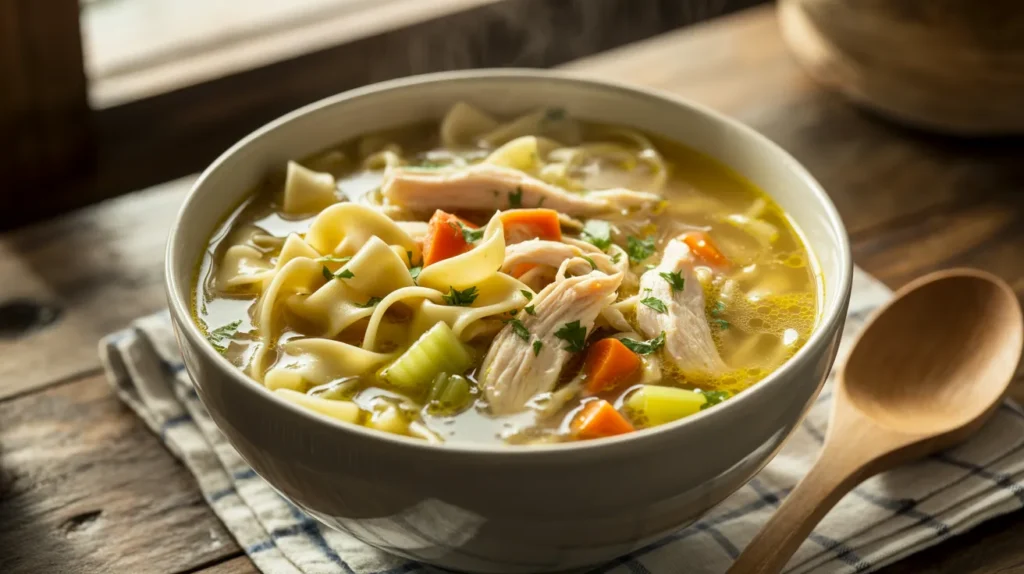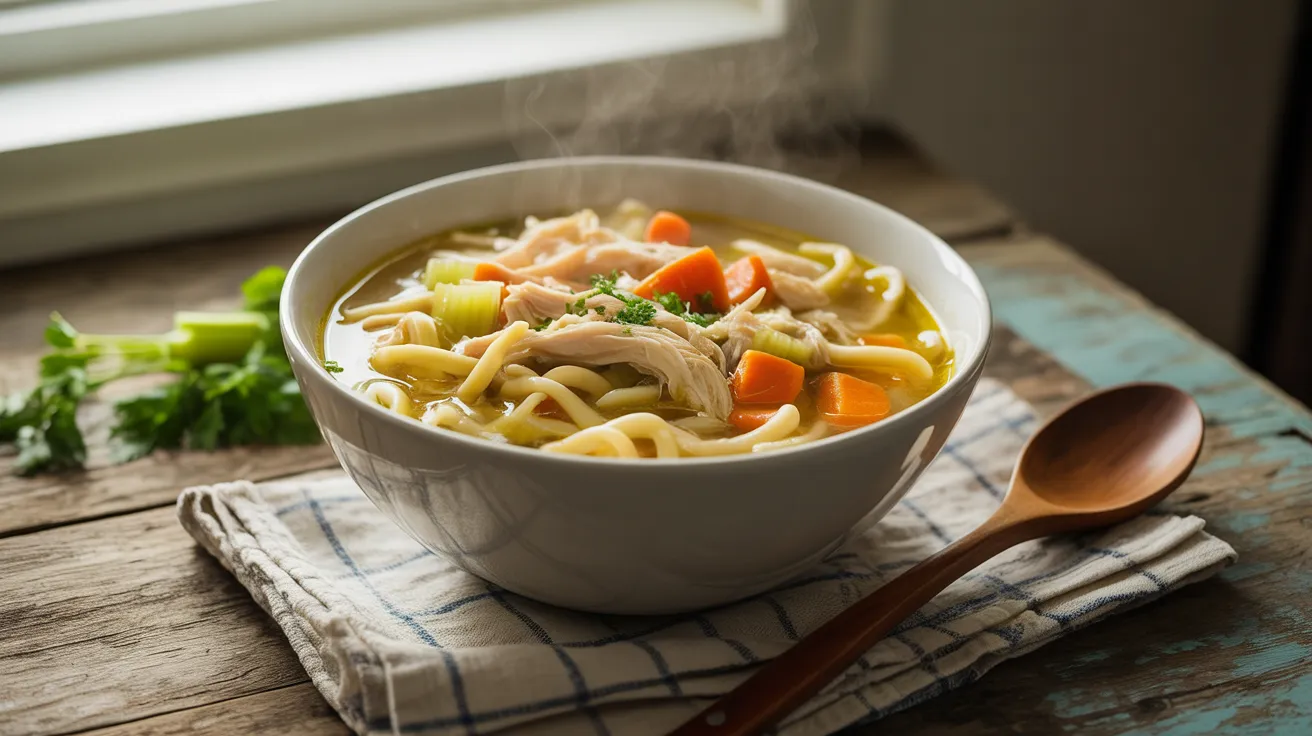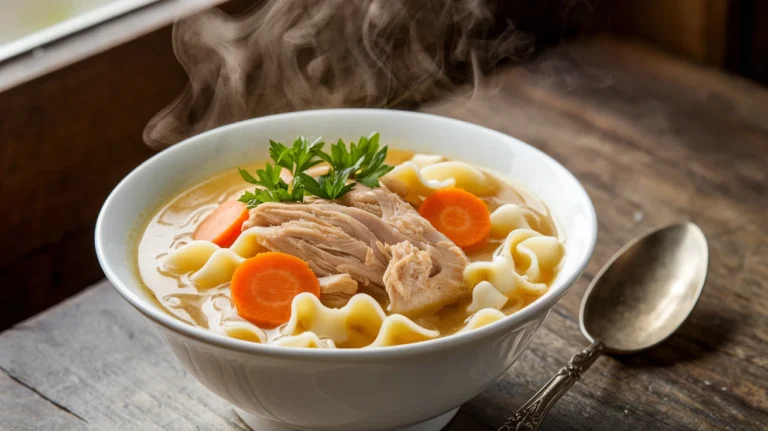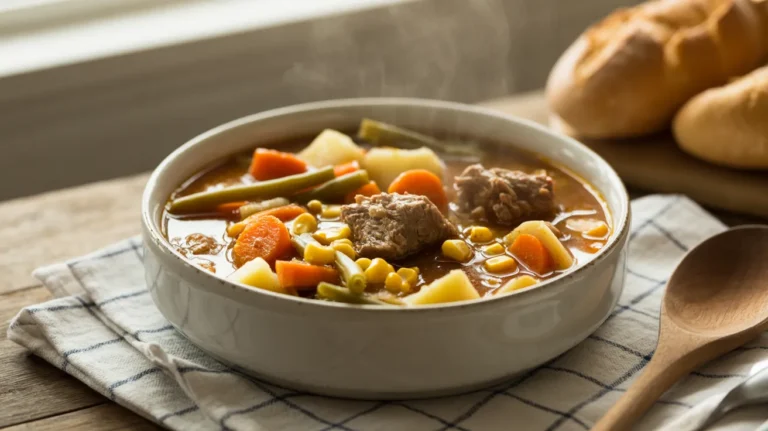This comforting homemade chicken noodle soup recipe transforms simple ingredients into a soul-warming meal that rivals any restaurant version. Perfect for beginners, this step-by-step guide shows you exactly how to create tender chicken, perfectly cooked vegetables, and flavorful broth from scratch. Whether you’re battling a cold or craving comfort food, this homemade chicken noodle soup delivers warmth and satisfaction in every spoonful.
Recipe Information
SERVES: 4 | PREP: 20 MIN | COOK: 25 MIN | TOTAL: 45 MIN
Ingredients for Perfect Homemade Chicken Noodle Soup
For the Soup Base:
| Ingredient | Amount | Notes |
|---|---|---|
| Boneless, skinless chicken breasts | 1 lb (about 2 large breasts) | Room temperature works best |
| Yellow onion, diced | 1 medium | Sweet onions work too |
| Carrots, sliced | 2 large | Peel and cut diagonally |
| Celery stalks, chopped | 2 stalks | Include some leaves for flavor |
| Garlic cloves, minced | 3 cloves | Fresh only, not powdered |
| Low-sodium chicken broth | 6 cups | Quality matters here |
| Bay leaves | 2 leaves | Remove before serving |
| Fresh thyme | 1 teaspoon | Or ½ tsp dried thyme |
| Salt | 1 teaspoon | Adjust to taste |
| Black pepper | ½ teaspoon | Freshly ground preferred |
| Olive oil | 2 tablespoons | Extra virgin for best flavor |
For the Noodles:
| Ingredient | Amount | Notes |
|---|---|---|
| Wide egg noodles | 8 oz | Don’t use thin noodles |
| Fresh parsley, chopped | ¼ cup | For garnish and flavor |
Detailed Step-by-Step Instructions for Homemade Chicken Noodle Soup
Phase 1: Preparing Your Vegetables and Aromatics (8-10 minutes)
Step 1: Set Up Your Workspace Before you begin cooking your homemade chicken noodle soup, arrange all ingredients on your counter. Wash and dry your vegetables thoroughly. Having everything ready makes the cooking process smooth and stress-free.
Step 2: Heat the Oil Properly Place a large, heavy-bottomed pot or Dutch oven (at least 6 quarts) on your stovetop over medium heat. Add 2 tablespoons olive oil and let it warm for 1-2 minutes. The oil is ready when it shimmers and moves easily around the pan but doesn’t smoke. If it starts smoking, reduce the heat immediately.
Step 3: Cook the Onions Until Translucent Add your diced onion to the warm oil. You should hear a gentle sizzling sound – this means your temperature is perfect. Stir the onions with a wooden spoon every 30-45 seconds. Cook for 3-4 minutes until the onions become translucent (you can see through them) and smell sweet. They should not turn brown at this stage.
Step 4: Add Garlic for Aromatic Base Add 3 minced garlic cloves to the onions. Stir constantly for 30-45 seconds – garlic burns quickly and becomes bitter if overcooked. You’ll know it’s ready when you smell that amazing garlic aroma filling your kitchen.
Step 5: Layer in the Vegetables Add chopped celery and sliced carrots to the pot. Stir everything together so the vegetables are coated with the oil and aromatics. Cook for 2-3 minutes, stirring occasionally. The vegetables should start to soften slightly but still have a crisp bite. This step builds layers of flavor in your homemade chicken noodle soup.
Phase 2: Building the Perfect Broth (18-20 minutes)
Step 6: Add Liquid and Seasonings Pour in 6 cups of low-sodium chicken broth slowly to avoid splashing. The liquid should cover the vegetables completely. Add 2 bay leaves, 1 teaspoon fresh thyme, 1 teaspoon salt, and ½ teaspoon black pepper. Stir gently to combine all ingredients.
Step 7: Bring to a Proper Boil Increase heat to medium-high and bring the mixture to a rolling boil. You’ll see large bubbles breaking the surface consistently. This should take about 5-7 minutes. Don’t walk away during this step – watch for the boil to begin.
Step 8: Season and Prepare the Chicken While waiting for the boil, pat your chicken breasts completely dry with paper towels. Season both sides generously with salt and pepper, pressing the seasonings into the meat. Room temperature chicken cooks more evenly than cold chicken straight from the refrigerator.
Step 9: Add Chicken to Simmering Broth Once your broth reaches a boil, carefully lower the seasoned chicken breasts into the pot using tongs. The chicken should be completely submerged. If not, add more broth or water until covered by at least 1 inch of liquid.
Step 10: Reduce to Gentle Simmer Immediately reduce heat to medium-low to maintain a gentle simmer. You should see small bubbles occasionally breaking the surface, not a rolling boil. Cover the pot with a lid slightly ajar (leave a small gap for steam to escape). Simmer for 15-18 minutes.
Step 11: Check Chicken for Doneness After 15 minutes, check the largest piece of chicken with an instant-read thermometer inserted into the thickest part. The internal temperature should read 165°F. If it’s not ready, continue cooking and check every 2-3 minutes. Properly cooked chicken will be completely white throughout with no pink areas and the juices will run clear.
Phase 3: Shredding Chicken and Final Assembly (12-15 minutes)
Step 12: Remove and Rest the Chicken Using clean tongs, carefully lift the cooked chicken from the hot broth and place on a large cutting board. Let the chicken rest for 3-5 minutes – this cooling time makes it safe to handle and easier to shred. Don’t skip this step or you’ll burn your fingers!
Step 13: Shred Chicken into Perfect Pieces Using two forks, hold one fork steady and use the other to pull the chicken apart following the natural grain of the meat. Create bite-sized pieces roughly ½ to ¾ inch in size. Remove any visible fat, gristle, or cartilage as you work. Well-shredded chicken distributes evenly throughout your homemade chicken noodle soup.
Step 14: Return Chicken to Broth Add all the shredded chicken back to your simmering pot. Stir gently to distribute the chicken evenly among the vegetables. Bring the soup back to a gentle boil over medium heat – this should take 2-3 minutes.
Step 15: Cook the Noodles Perfectly Add 8 ounces wide egg noodles to the boiling soup. Stir immediately to prevent sticking, then stir every 2-3 minutes during cooking. Cook according to package directions (usually 6-8 minutes) until the noodles are tender but still have a slight bite (al dente). Overcooked noodles become mushy and absorb too much broth.
Step 16: Final Seasoning and Fresh Herbs Remove the bay leaves with tongs or a spoon – they’ve done their job flavoring the broth. Taste your soup and adjust seasoning with additional salt and pepper as needed. Remember, you can always add more but you can’t take it out. Remove from heat and stir in fresh chopped parsley for color and bright flavor.
Step 17: Serve Your Perfect Homemade Chicken Noodle Soup Ladle the hot soup into warmed bowls, making sure each serving gets an equal amount of chicken, vegetables, and noodles. Serve immediately while steaming hot. Provide extra salt, pepper, and fresh parsley at the table for individual preferences.
Expert Chef’s Notes for Homemade Chicken Noodle Soup
Chicken Selection: Boneless, skinless chicken breasts create the cleanest flavor profile for your homemade chicken noodle soup. Chicken thighs add more flavor but require 5-10 minutes longer cooking time and careful fat removal.
Noodle Success: Wide egg noodles hold up better than thin varieties and provide the perfect texture. Cook them directly in the broth for maximum flavor absorption, but only add when ready to serve.
Vegetable Texture: Cut all vegetables to similar sizes for even cooking. Carrots should be sliced on the diagonal for elegant presentation and faster cooking.
Broth Enhancement: Start with quality low-sodium chicken broth so you control the final salt level. The vegetables and chicken will add natural flavors as they simmer.
Nutrition Information (Per Serving)
- Calories: 340
- Protein: 28g
- Carbohydrates: 32g
- Fat: 12g
- Fiber: 3g
- Sodium: 890mg
Creative Variations of Homemade Chicken Noodle Soup
Creamy Comfort Version: Transform your homemade chicken noodle soup into a rich, creamy delight by stirring in ½ cup heavy cream during the last 5 minutes of cooking. This creates a restaurant-style soup perfect for special occasions.
Time-Saving Rotisserie Style: Skip the chicken cooking step entirely by using store-bought rotisserie chicken. Simply shred 3 cups of meat and add during the final 5 minutes. Our rotisserie chicken noodle soup guide provides complete instructions for this shortcut method.
Asian-Inspired Twist: Replace thyme with fresh grated ginger and add a tablespoon of low-sodium soy sauce for an umami-rich variation. Try our ginger garlic chicken noodle soup for a complete recipe with detailed instructions.
Vegetable-Packed Power Bowl: Double the nutrition by adding diced potatoes, corn kernels, or green beans during the vegetable cooking phase. This creates a hearty, meal-in-a-bowl version that’s perfect for growing families.
Storage & Reheating Your Homemade Chicken Noodle Soup
Refrigerator Storage: Store cooled soup in airtight containers for up to 4 days. The noodles will continue absorbing broth, so add extra liquid when reheating.
Freezer Storage: Freeze soup without noodles for up to 3 months in freezer-safe containers. Leave 1 inch headspace for expansion. Cook fresh noodles when ready to serve.
Reheating Instructions: Warm gently on stovetop over medium-low heat, stirring frequently. Add extra broth or water to reach desired consistency. Microwave individual portions for 1-2 minutes, stirring halfway through.
Make-Ahead Strategy: Prepare the complete soup base without noodles up to 2 days ahead. Store refrigerated and add fresh noodles when ready to serve for best texture.

Troubleshooting Common Homemade Chicken Noodle Soup Problems
Problem: My noodles turned mushy and absorbed all the broth. Solution: Cook noodles separately in salted water, then add to individual bowls before ladling hot soup over them. This prevents overcooking during storage.
Problem: The chicken came out tough and rubbery. Solution: Don’t overcook the chicken. Use an instant-read thermometer and remove at exactly 165°F. Overcooked chicken becomes tough and dry in your homemade chicken noodle soup.
Problem: My soup tastes bland and lacks flavor. Solution: Season in layers throughout cooking. Salt the chicken before adding to broth, taste after simmering, and adjust seasoning before serving. Quality broth makes a huge difference.
Problem: The vegetables are either too crunchy or completely mushy. Solution: Add harder vegetables like carrots first, then softer ones like celery. Cook just until tender-crisp – they’ll continue cooking in the hot broth.
Problem: My soup is too thin and watery. Solution: Simmer uncovered for 10-15 minutes to reduce liquid naturally. Alternatively, mix 2 tablespoons flour with ¼ cup cold water and stir into simmering soup.
Essential Equipment for Perfect Homemade Chicken Noodle Soup
- Large heavy-bottomed pot or Dutch oven (6-8 quart capacity minimum)
- Sharp chef’s knife for precise vegetable chopping
- Large cutting board (use separate board for raw chicken)
- Wooden spoon for stirring without scratching your pot
- Long-handled tongs for safely handling hot chicken
- Measuring cups and spoons for accurate proportions
- Instant-read meat thermometer for food safety
- Fine-mesh strainer for removing bay leaves if needed
Complete Shopping List for Homemade Chicken Noodle Soup
Meat Counter:
- 1 pound boneless, skinless chicken breasts
Produce Section:
- 1 medium yellow onion
- 2 large carrots
- 2 celery stalks with leaves
- 1 head fresh garlic
- Fresh thyme sprigs
- Fresh parsley bunch
Pantry/Dry Goods:
- 8 ounces wide egg noodles
- 6 cups low-sodium chicken broth
- Dried bay leaves
- Sea salt or kosher salt
- Whole black peppercorns
- Extra virgin olive oil
Five Success Secrets for Restaurant-Quality Homemade Chicken Noodle Soup
1. Build Flavor Layers Slowly – Don’t rush the vegetable sautéing step. Properly cooked aromatics create the flavor foundation that makes your homemade chicken noodle soup taste like it simmered all day.
2. Temperature Control is Everything – Use an instant-read thermometer to ensure chicken reaches exactly 165°F. Overcooked chicken becomes tough and ruins the texture of your finished soup.
3. Shred While Warm for Best Texture – Chicken shreds most easily when it’s still warm from cooking. Let it cool just enough to handle safely, then shred immediately for perfect bite-sized pieces.
4. Season Throughout the Process – Add salt and pepper at multiple stages rather than just at the end. This builds complex, well-balanced flavors that penetrate every component of your homemade chicken noodle soup.
5. Fresh Herbs Make the Difference – Add fresh parsley just before serving to brighten the entire bowl. Fresh herbs provide color, aroma, and a flavor pop that dried herbs simply can’t match.
This beginner-friendly homemade chicken noodle soup recipe creates the ultimate comfort food experience with tender chicken, perfectly cooked vegetables, and aromatic broth. Master these detailed techniques once, and you’ll have a go-to recipe that brings warmth and satisfaction to any table.




